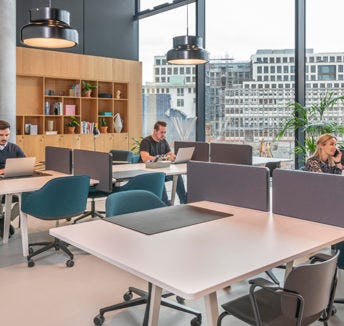
The way we measure productivity – and how we define it – is changing in the hybrid world.
The hybrid working revolution – which lets people work remotely at home and at local workspaces, making the occasional visit to head office – can pose a challenge both for people who work for and for people who run small businesses or start-ups.
If somebody is out of sight, and only glimpsed occasionally on Zoom, how can they demonstrate they are being productive? On the other side, if you’re an employer, how do you know you’re getting value for money? For some, the answer lies in technology.
A growing number of tools are now available for employers to monitor the activities of remote workers and freelancers. Some programmes, such as Time Doctor, enable workers to track the amount of time they actually spend working.
“When your employees see how tracking their time gives them valuable knowledge about their strengths and weaknesses – when they are overwhelmed and when they are underutilised – you’ll be amazed at how productive, accountable and self-directed they become,” says Time Doctor.
Project management tools such as Asana and Trello which make it easier for remote colleagues to collaborate virtually on projects, can also play a role in monitoring productivity. The time that a task is completed is usually logged – and the same applies when a message is sent or a file is uploaded – enabling everybody to keep sight of project timelines.
However, the line between monitoring productivity and invading privacy can be a fine one.
Some companies have been criticised for considering the use of facial recognition tools that can tell whether an employee is at their desk when they are supposed to be. Such technology could also capture images of an employee’s housemates, which would be hugely intrusive.
Productivity in a hybrid world
Seeing productivity simply in terms of time spent working at a screen may be missing the point in the hybrid world. A 2021 survey by Microsoft of more than 30,000 global workers found that productivity actually remained the same or was higher for more than four-fifths of employees when they were working remotely for much of the time. Meetings were going on for longer, more emails were being sent and more documents were being worked on. But, at the same time, more than half felt overworked, and more than a third said they felt exhausted.
“While it may be tempting to equate high levels of employee activity with success, doing so misses the factors that drive long-term sustainable innovation,” Microsoft Chief Scientist Jaime Teevan wrote in Harvard Business Review. “We must expand the way we think about productivity to focus on wellbeing, social connections and collaboration, and the innovation they bring to drive business success.”
Teevan suggests that remote workers or freelancers should be allowed to design their days to include other priorities such as family, fitness or hobbies, and they should take a nap if they need one. And she says teams need to carefully plan how and when they want to work together in person to make the most from collaboration.
Last year, Arup, the employee-owned global engineering and design firm, introduced ‘Work Unbound’ to give its 15,500 employees, known as ‘members’, greater flexibility in deciding how, when and where they work.
Following an initial three-month trial period that was conducted in spring 2019, 87% of Arup members said they felt their productivity improved along with work-life balance and wellbeing. They also felt that offering greater flexibility would be beneficial when trying to attract new talent.
Many experts agree that, in the new hybrid world, the focus for employers should increasingly be on outcomes rather than output.
VaynerMedia London MD Sarah Baumann wrote in a recent comment piece for AdWeek: “Workers have figured out that they work best when life works with work. People want to talk to their employers about the demands of their daily life and to have an immediate ear and action plan. They want employers to accept once and for all that flexibility can genuinely enhance productivity, not reduce it.”
The changing way we measure productivity in a hybrid world is one of ten trends identified in IWG’s white paper, The Future of Work: a trends forecast for 2022.
Find out how Spaces can help you and your company transition towards a hybrid solution.
Enjoy this? You might also like these Spaces magazine stories:
Share this article
 Read now The trends shaping work in 2022: green dividends
Read now The trends shaping work in 2022: green dividends
 Read now The trends shaping work in 2022: virtual collaboration
Read now The trends shaping work in 2022: virtual collaboration